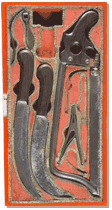


Seventeenth century amputation set
In a period prior to the discovery of Anesthesia the surgeon was asked to execute an amputation in seconds, performance also required to the instrument. The curvilinear shape of the amputation knives aimed at shortening and simplifying the operatory work. We can thereafter verify that the set is not complete; this is not a rare situation and can be explained by the deficient resistance to corrosion and degradation of some of the materials in use. The empty spaces suggest shapes and, taking in account the aforementioned experience, we might suppose that the missing instruments could be a screw tourniquet (maybe a wooden one), an amputation knife (maybe interosseous) and a needle. Although the pointed physical methods of hæmostasis - the artery forceps and the probable screw tourniquet - were known its use was not vulgarized, which is a fact that emphasizes the value of this set. Once more the incessant observation of instruments and iconographic reproductions allowed the identification of the artery forceps, according to the model of L. Heister (1683 - 1758), which reinforces its historical value. The Seton consisted of a small surgery where a string was pushed through the skin and then pulled out of it again; this string could be made of several materials and this piercing was meant to shield the humoral balance. The posterior cervical region was the most often chosen. In this set we can see a Seton needle, which is frequently seen together with amputation instruments. The set decoration excludes an English, French or German origin. It may have an Iberian or Italian provenience. It is an enigma. The manufacturer mark, should there be one, would clarify the place and date of its production, although there are signs that, when analyzed as a whole, can be highly elucidative. The study of the surgical instruments forms a continuous cycle of national research and worldwide interchange.
